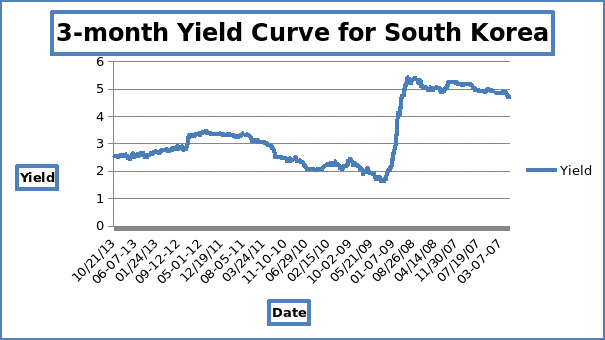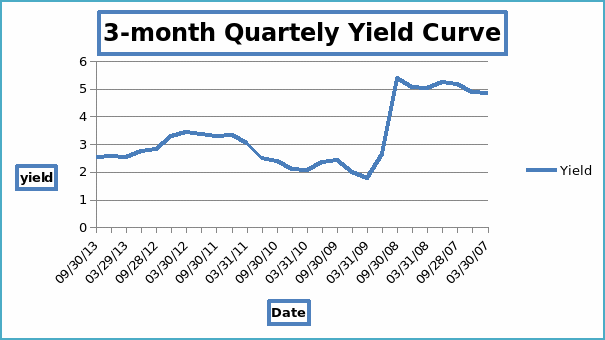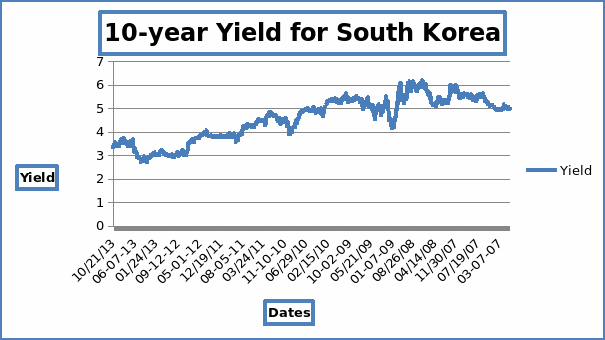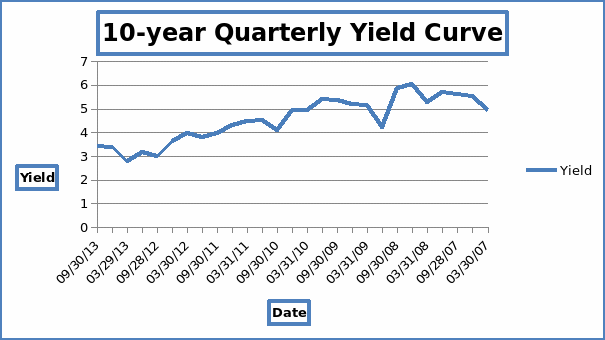3-month yield curve
The graph presented below shows the 3-month yield curve between the period of 2013 and 2007.

The graph presented below shows the 3-month quarterly yield curve.

10-year yield curve
The graph presented below shows the 3-month yield curve between the period of 2013 and 2007.

The graph presented below shows the 10-year quarterly yield curve.

Discussion
Based on the analysis of the graphs presented above, it can be observed that the four graphs had the same trend before and after the sub-prime mortgage crisis. The country experienced advancement in the yield between 2007 and 2008. However, towards the end of 2008, the country experienced a slump in the yield. It can be observed that the other variables in the economy of South Korea that affect the yield also fluctuated during the same period (Bloomberg L.P 1a). For instance, the GDP of the country increased between 2007 and 2008. Between 2009 and 2010, the GDP declined by a large margin. From 2010, the value increased gradually. This shows that there exists a direct relationship between the amount of GDP and the yield. An increase in GDP results in an increase in the yield. The central bank benchmark interest rate followed the same trend as the yield. In most countries, the yield is always determined by the central bank benchmark interest rate. Therefore, there seem to be a direct association between the benchmark rate and yield. Besides, it can be observed that the central bank decided to adopt a conservative interest rate policy after the crisis. This contributed to the low yield reported after the crisis. Further, the low benchmark rates also resulted in low inflation rate especially after the crisis. It can be observed that the inflation rates are extremely low (lower than global rate) and cannot allow the economy to recover. International trade was also affected by the global crisis. The country experienced a decline in revenues from exports. This also contributed to a decline in the amount of GDP.
From the analysis of the values of economic indicators, it can be observed that the country has not recovered fully from the global crisis. The failure to recover from the crisis can be attributed to a one key factor, that is, the central bank benchmark interest rate policy. As mentioned above, the central bank decided to maintain a low interest rate after the recession. However, the low rates of return results in capital outflow because investors will move to countries that offer higher rates. Also, low interest rate results in low yield. The crisis impacted negatively on the government budget. The government experienced a decline in budget surplus. Specifically, in 2010, South Korea had a budget deficit due to the decline in revenues (Bloomberg L.P 1b; Arnold 78).
Implication
The current policy of the South Korea country on interest rate is undesirable because it cannot attract growth in the economy. The country will need to come up with an aggressive policy that offers high yield. The export trade is picking up and the country can now report surplus in the trade balance. However, this is not sustainable because most of the trade partners have not recovered fully from the global financial crisis. Thus, it will be necessary to attract investment by increasing the interest rates (Bloomberg L.P 1c). Therefore, the country needs to employ the two strategies to enable it achieve higher yields that were reported before the sub-prime mortgage crisis.
Works Cited
Arnold, Roger. Economics, USA: Cengage Learning, 2011. Print.
Bloomberg L.P 2013a, DBS’s Lauschke Sees 10-Year Korean Bond Yield Rising to 4.3%. Web.
Bloomberg L.P 2013b, Market Data. Web.
Bloomberg L.P 2013c, South Korean Yield Curve to Steepen as Economy Rebounds. Web.